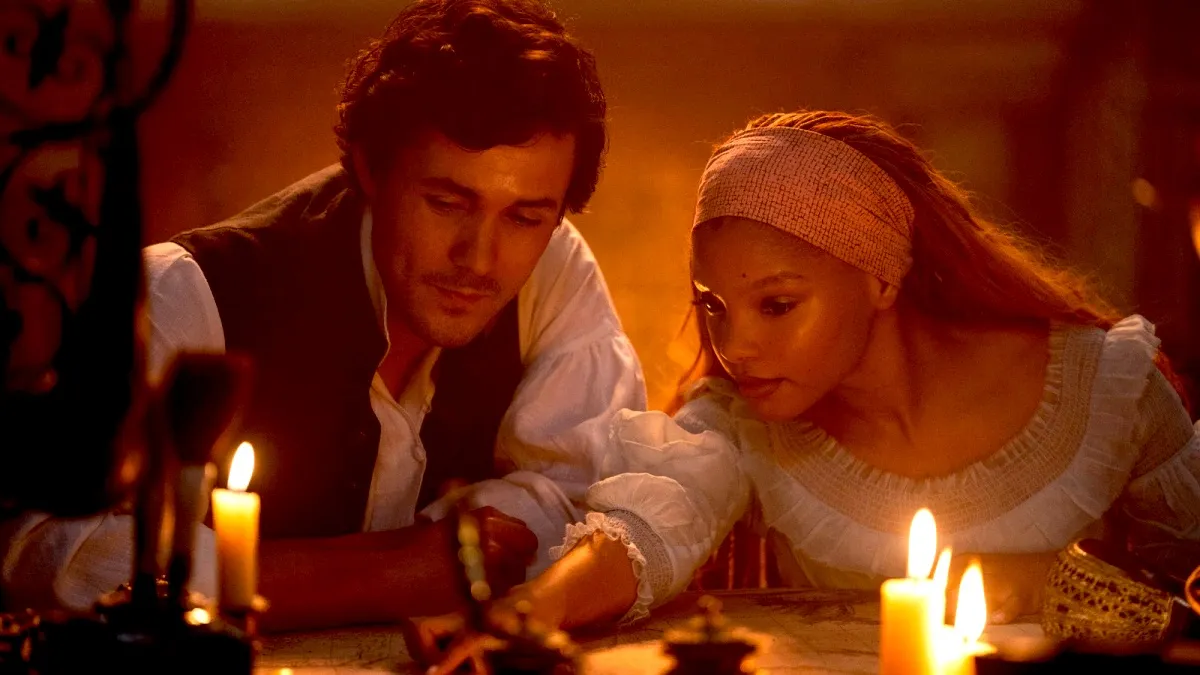‘The Little Mermaid’s Setting Opens Up an Important, Complicated Conversation About Slavery
Written by on June 11, 2023
The Little Mermaid premiered on May 26, 2023, and has been making quite a splash as a live-action remake of the 1989 animated film of the same name. The film has been garnering attention since it first entered development for many reasons, unfortunately including bigots taking issue with the casting of Halle Bailey as Ariel, and the modernization of several plot points and songs.
As a result, The Little Mermaid has weathered much backlash, review bombing, and other attacks from racist trolls. Despite all this, The Little Mermaid’s reviews have leaned toward the positive, and it’s doing big numbers at the box office.
However, just because it rose above attacks from trolls and featured a more diverse and contemporary retelling of Ariel’s story doesn’t mean it’s a perfect film. Its decision to wash away Ursula’s (Melissa McCarthy) drag queen inspiration AND hide her curvey queen body was a big disappointment. Another point worthy of criticism was brought up by journalist Marcus Ryder: Even if The Little Mermaid does historically feature the first Black Ariel, some serious whitewashing still occurs in the film, most notably in how The Little Mermaid ignores the fact that slavery existed in the place and time period that its creators chose for its setting.
Of course, that’s not to say The Little Mermaid needed to feature slavery because of its casting choices. That itself would be pretty racist, but that wasn’t Ryder’s point, despite how the conversation has evolved online. Instead, it’s worth discussing how slavery is removed from a historical setting: Is it because the film is a fantasy, or does it choose a specific real-world setting and then paper over its history, when a little more storytelling creativity could have accomplished something more?
Marcus Ryder calls out The Little Mermaid for ignoring slavey

While the film partially takes place underwater, in the fictional underwater kingdom of Atlantica, much of it also takes place in the above world. The world above water does not appear to be a wholly fictional realm. Even back when the 1989 animated The Little Mermaid premiered, fans debated about whether the outside world was set in Italy or Denmark. The remake drops many hints that it is set in the Caribbean in the 18th century. The architecture, costumes, dances, street markets, and ship designs all point to Caribbean influence and a 1700s setting.
The Caribbean was at the center of the transatlantic slave trade during this period. By the mid-18th century, the Caribbean had surpassed even Brazil as the primary destination for enslaved Africans. Meanwhile, as Ariel explores the Caribbean island where the story takes place, The Little Mermaid even specifically mentions Brazil, another country that was notorious for its involvement in the slave trade in that time period.
Based on this history, Ryder questioned how The Little Mermaid could choose such a setting and then not make any reference to slavery. Not only does it not mention slavery, but it shows the entire island living in racial harmony.
Ryder discussed his thoughts on that choice, and the rest of The Little Mermaid, in a post on his blog, Black on White TV. He discussed the merits of the film, especially how it goes against white beauty standards in casting Bailey as the Princess of the Sea, and said, “A world in which the very idea of race for the main characters seems to be subverted, consciously ignored, and at the same time Black beauty is celebrated, needs to be applauded.”
However, he criticized it for “pretending that slavery didn’t exist,” though he made the important point that not every story set in the past needs to tackle the issue:
So does this mean Black children cannot have escapist fantasies of the past, or all our historical stories have to overtly address racism and slavery?
Definitely not.
He also wasn’t suggesting this movie, even with its setting, should have focused on or even featured the horrors of slavery, but he did suggest how it could have kept that setting but made small changes to accomplish its goals without getting too deep into slavery or whitewashing real history, subtly educating kids without weighing down its intended story.
He proposed that the film could’ve taken place in Haiti following the Haitian Revolution in 1804, when slavery was permanently outlawed: “A post revolutionary Haiti would have been the perfect setting for an island of racial harmony, and in doing so it would have gently educated children about an important period in world history.” Or it could’ve gotten really creative and seen Ariel fall in love with a runaway slave in the Caribbean. Instead, it kept its setting in a vague time and place where slavery existed and made it seem as if it didn’t. With many politicians and parents today trying to prevent children from being taught that slavery existed, this erasure of slavery feels like a missed opportunity, despite the film’s high points.
The growing problem of how TV/film handles race
Unfortunately, the problem isn’t isolated to The Little Mermaid. Bridgerton is another show that has badly handled race and history. Shows and films increasingly want to depict diversity but don’t want to give up their chosen timeline and setting to make a racially diverse cast work. For example, Bridgerton decided to explain away racism by making it seem as if the marriage of King George III and Queen Charlotte suddenly ended racism (even though slavery still exists in the Bridgerton world).
It would’ve been so much less messy if the show had just created a completely fictional realm or fully alternative history—which many fans were hoping to see from it—rather than acknowledge the real-world issues only to appear to hand-wave them. Trying to parallel the actual Regency period but then unrealistically and messily explaining away racism and slavery has been criticized for ultimately being the worse way to handle it.
What The Little Mermaid and Bridgerton make clear is that casting Black actors is only part of creating authentic representation and diversity. Acknowledging historical context is the other part. As Ryder points out, there are so many creative and subtle ways in which these situations could be remedied.
The decision to set the film in a world that was seemingly meant to look like the 18th century Caribbean minus the slavery is worth looking at critically. The film paints a picture of a place and time that distorts, ignores, and erases a very painful and real part of history, and it does so for an audience of children who use these stories to understand the real world.
(featured image: Disney)
Have a tip we should know? [email protected]
watch avatar the way of water full movie
watch avatar the way of water full movie
watch avatar the way of water full movie




